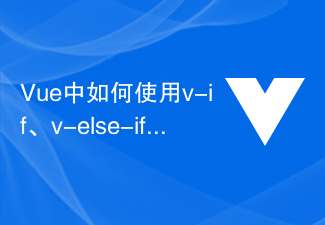 Web Front-end
Web Front-end Vue.js
Vue.js Advanced skills in Vue conditional rendering: master v-if, v-show, v-else, v-else-if to implement complex logical judgments
Advanced skills in Vue conditional rendering: master v-if, v-show, v-else, v-else-if to implement complex logical judgments
Vue is a popular front-end framework that provides many flexible features, among which conditional rendering is one of the commonly used functions in development. In Vue, we can use v-if, v-show, v-else, v-else-if and other instructions to implement complex logical judgment and conditional rendering. This article explains how to use these directives and provides some specific code examples.
The v-if instruction is the most commonly used conditional rendering instruction. You can add the v-if attribute to a DOM element to determine whether to render the element based on conditions. The v-if directive adds or removes DOM elements based on whether an expression is true or false. For example, we can display different content based on whether the user is logged in:
<template>
<div>
<div v-if="isLoggedin">
欢迎回来,{{ username }}!
</div>
<div v-else>
请登录后查看内容。
</div>
</div>
</template>
<script>
export default {
data() {
return {
isLoggedin: false,
username: 'John'
}
}
}
</script>In the above code, based on the value of isLoggedin, we can decide to display a welcome message or a login prompt. When isLoggedin is true, the welcome message is displayed, otherwise the login prompt is displayed.
The v-show instruction is similar to the v-if instruction. It can also control the display and hiding of elements based on conditions. However, it does not remove the DOM structure. It only controls the visibility of the element by setting the display attribute of the element. sex. When using the v-show directive, the element always exists in the DOM, and the display attribute is only set based on conditions to determine whether to display it. The following is an example:
<template>
<div>
<button @click="toggle">切换</button>
<div v-show="isShow">
这是一个隐藏的元素。
</div>
</div>
</template>
<script>
export default {
data() {
return {
isShow: false
}
},
methods: {
toggle() {
this.isShow = !this.isShow;
}
}
}
</script>In the above code, we control the display and hiding of elements by clicking the button to switch the value of isShow.
In addition to v-if and v-show, Vue also provides v-else and v-else-if instructions to handle multi-condition rendering situations. v-else is used in conjunction with v-if, which means that if the previous v-if condition is not true, the content of v-else will be executed. v-else-if is used to switch between multiple conditions, and its usage is similar to v-else. The following is an example of multi-condition rendering:
<template>
<div>
<div v-if="score >= 90">
优秀
</div>
<div v-else-if="score >= 60">
及格
</div>
<div v-else>
不及格
</div>
</div>
</template>
<script>
export default {
data() {
return {
score: 80
}
}
}
</script>In the above code, based on the value of score, we can determine the student's performance level. If the score is greater than or equal to 90, "Excellent" is displayed; if the score is greater than or equal to 60, "Pass" is displayed; otherwise, "Fail" is displayed.
By mastering the conditional rendering instructions of v-if, v-show, v-else, v-else-if, we can flexibly respond to various complex logical judgment requirements in Vue development. The code examples given above can help you better understand how to use these instructions. I hope this article will be helpful for everyone to learn Vue's conditional rendering.
The above is the detailed content of Advanced skills in Vue conditional rendering: master v-if, v-show, v-else, v-else-if to implement complex logical judgments. For more information, please follow other related articles on the PHP Chinese website!
 Vue报错:无法正确使用v-if指令进行条件渲染,如何解决?Aug 19, 2023 pm 01:09 PM
Vue报错:无法正确使用v-if指令进行条件渲染,如何解决?Aug 19, 2023 pm 01:09 PMVue报错:无法正确使用v-if指令进行条件渲染,如何解决?在Vue开发中,经常会使用v-if指令来根据条件来渲染页面中的特定内容。然而,有时我们可能会遇到一个问题,当我们正确使用v-if指令时,却无法得到期望的结果,并且会收到报错信息。本文将介绍这个问题的解决方法,并提供一些示例代码来帮助理解。一、问题描述通常,我们在Vue模板中通过v-if指令来判断是否
 Vue3中的v-if函数:动态控制组件渲染Jun 19, 2023 am 08:31 AM
Vue3中的v-if函数:动态控制组件渲染Jun 19, 2023 am 08:31 AMVue3中的v-if函数:动态控制组件渲染Vue3是目前前端开发中最常用的框架之一,其拥有的父子组件通信、数据双向绑定、响应式更新等特性,被广泛应用于前端开发中。本文将着重介绍Vue3中的v-if函数,探讨其如何动态控制组件的渲染。v-if是Vue3中的一种指令,用于控制组件或元素是否渲染到视图中。当v-if的值为真时,组件或元素将会被渲染到视图中;而当v
 vue中v-if和v-for哪个优先级高Jul 20, 2022 pm 06:02 PM
vue中v-if和v-for哪个优先级高Jul 20, 2022 pm 06:02 PM在vue2中,v-for的优先级高于v-if;在vue3中,v-if的优先级高于v-for。在vue中,永远不要把v-if和v-for同时用在同一个元素上,会带来性能方面的浪费(每次渲染都会先循环再进行条件判断);想要避免出现这种情况,可在外层嵌套template(页面渲染不生成dom节点),在这一层进行v-if判断,然后在内部进行v-for循环。
 如何解决Vue报错:无法正确使用v-show指令Aug 17, 2023 pm 01:45 PM
如何解决Vue报错:无法正确使用v-show指令Aug 17, 2023 pm 01:45 PM如何解决Vue报错:无法正确使用v-show指令Vue是一款流行的JavaScript框架,它提供了一套灵活的指令和组件,使得开发单页面应用变得轻松且高效。其中v-show指令是Vue中常用的一个指令,用于根据条件动态显示或隐藏元素。然而,在使用v-show指令时,有时会遇到一些错误,如无法正确使用v-show指令导致元素不显示。本文将介绍一些常见的错误原因
 Vue3中的v-if函数详解:动态控制组件渲染的应用Jun 18, 2023 pm 02:21 PM
Vue3中的v-if函数详解:动态控制组件渲染的应用Jun 18, 2023 pm 02:21 PMVue3中的v-if函数详解:动态控制组件渲染的应用Vue3是一款流行的前端框架,其中的v-if指令是常用的动态控制组件渲染的方式之一。在Vue3中,v-if函数的应用有着广泛的用途,对于前端开发人员而言,掌握v-if函数的使用方法是非常重要的。什么是v-if函数?v-if是Vue3中的指令之一,它可以根据条件动态控制组件的渲染。当条件为真时,v-if渲染组
 解决Vue报错:无法正确使用v-show指令进行显示和隐藏Aug 19, 2023 pm 01:31 PM
解决Vue报错:无法正确使用v-show指令进行显示和隐藏Aug 19, 2023 pm 01:31 PM解决Vue报错:无法正确使用v-show指令进行显示和隐藏在Vue开发中,v-show指令是一个用于根据条件是否显示元素的指令。然而,有时我们可能会遇到在使用v-show时出现报错的情况,导致无法正确地进行显示和隐藏。本文将为大家介绍一些解决方法,并提供一些代码示例。指令使用错误在Vue中,v-show指令是一个条件指令,它根据表达式的真假来决定元素是否显示
 Vue中如何使用v-show与v-if结合实现动态页面渲染Jun 11, 2023 pm 11:27 PM
Vue中如何使用v-show与v-if结合实现动态页面渲染Jun 11, 2023 pm 11:27 PMVue是一种流行的JavaScript框架,用于构建动态Web应用程序。v-show和v-if都是Vue中用于动态渲染视图的指令。它们可以帮助我们在不显示或隐藏DOM元素时更好地控制页面。本文将详细说明如何在Vue中使用v-show和v-if指令结合使用来实现动态页面渲染。Vue中的v-show指令v-show是Vue中一个指令,它根据表达式的值来动态显示
 Vue中如何使用v-if、v-else-if、v-else实现多重条件渲染Jun 11, 2023 am 09:33 AM
Vue中如何使用v-if、v-else-if、v-else实现多重条件渲染Jun 11, 2023 am 09:33 AMVue是一种流行的JavaScript框架,主要用于构建交互式Web应用程序。在Vue中,我们可以使用v-if、v-else-if和v-else指令实现多重条件渲染。v-if指令用于根据条件渲染DOM元素,只有在条件为真时才会渲染元素。v-else-if和v-else指令则用于在v-if指令中使用多个条件。下面我们将详细介绍如何使用这些指令来实现多重条件渲染


Hot AI Tools

Undresser.AI Undress
AI-powered app for creating realistic nude photos

AI Clothes Remover
Online AI tool for removing clothes from photos.

Undress AI Tool
Undress images for free

Clothoff.io
AI clothes remover

AI Hentai Generator
Generate AI Hentai for free.

Hot Article

Hot Tools

WebStorm Mac version
Useful JavaScript development tools

DVWA
Damn Vulnerable Web App (DVWA) is a PHP/MySQL web application that is very vulnerable. Its main goals are to be an aid for security professionals to test their skills and tools in a legal environment, to help web developers better understand the process of securing web applications, and to help teachers/students teach/learn in a classroom environment Web application security. The goal of DVWA is to practice some of the most common web vulnerabilities through a simple and straightforward interface, with varying degrees of difficulty. Please note that this software

Zend Studio 13.0.1
Powerful PHP integrated development environment

Dreamweaver Mac version
Visual web development tools

Notepad++7.3.1
Easy-to-use and free code editor





